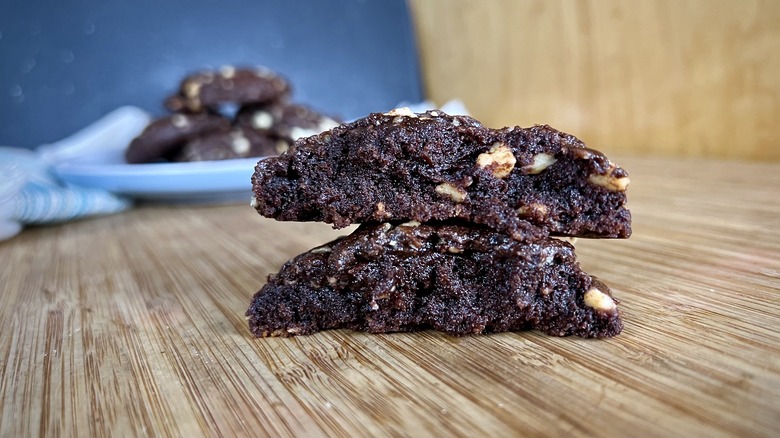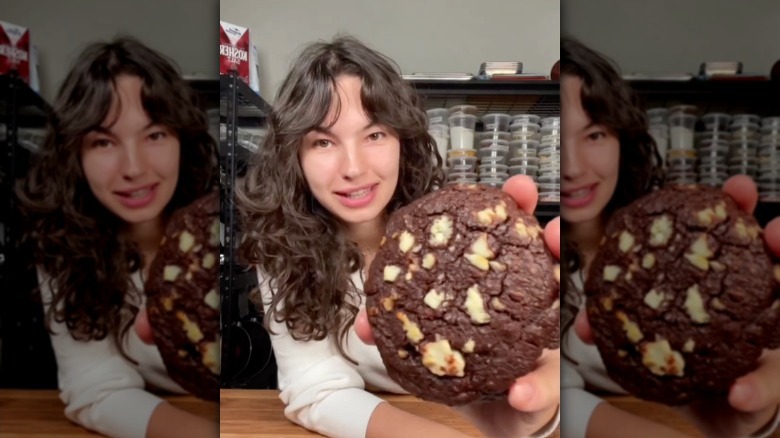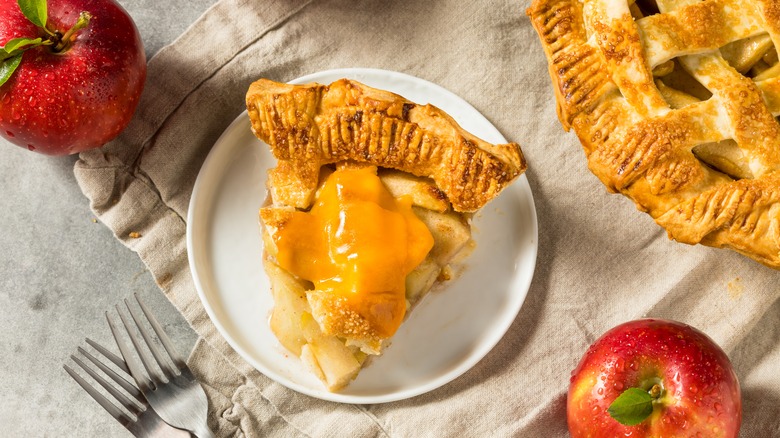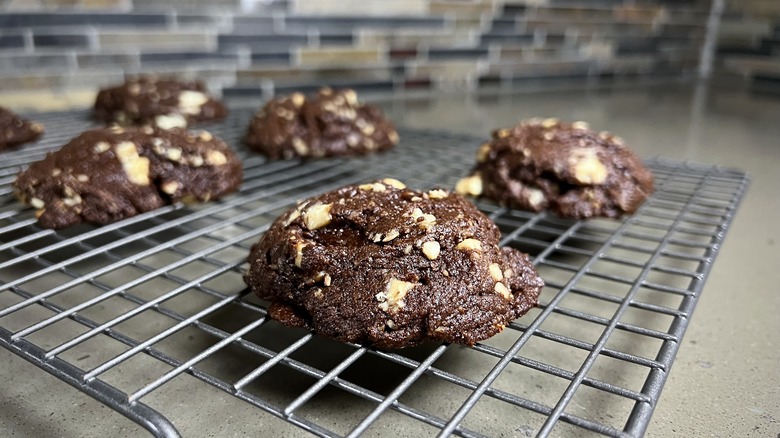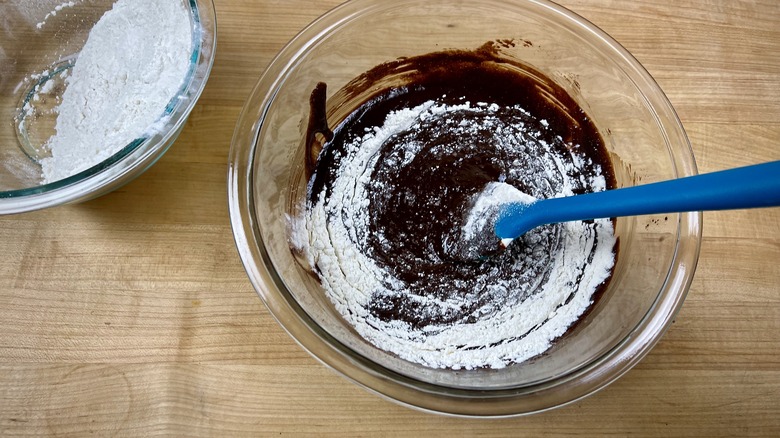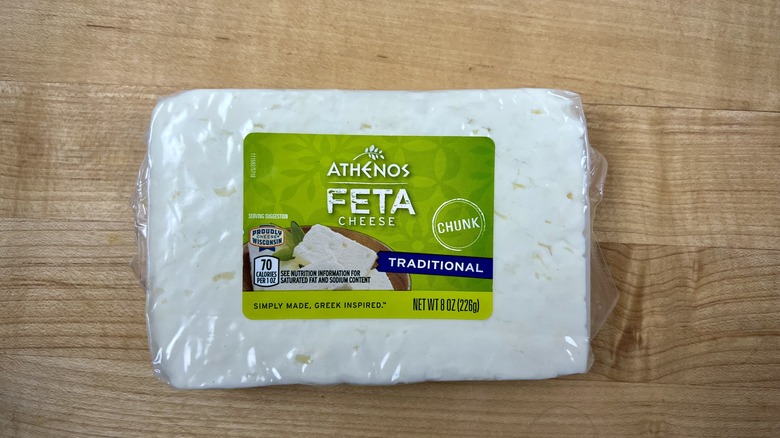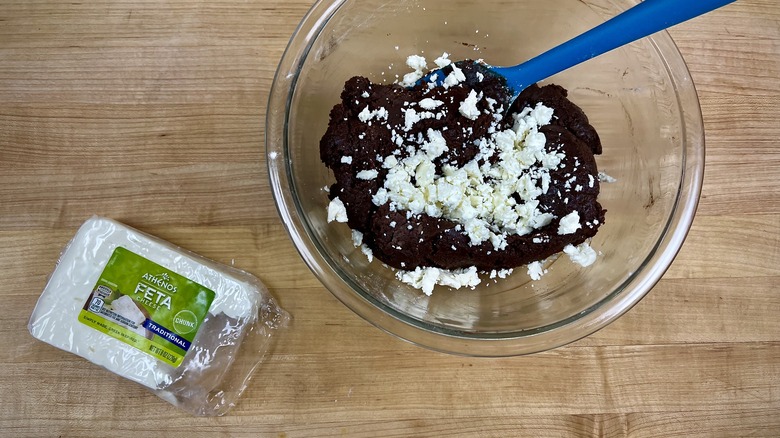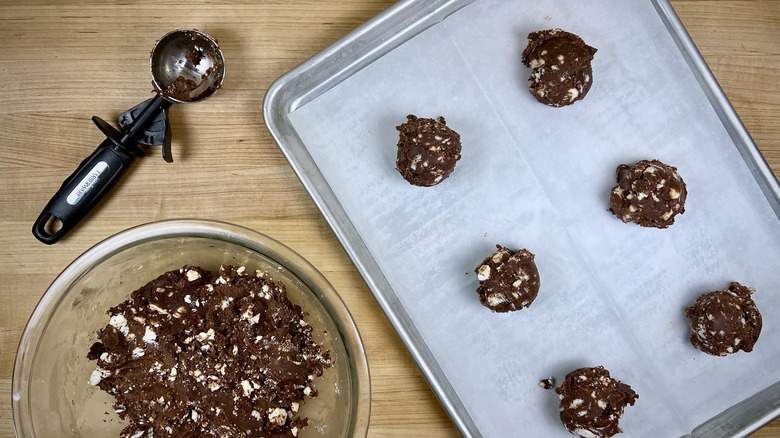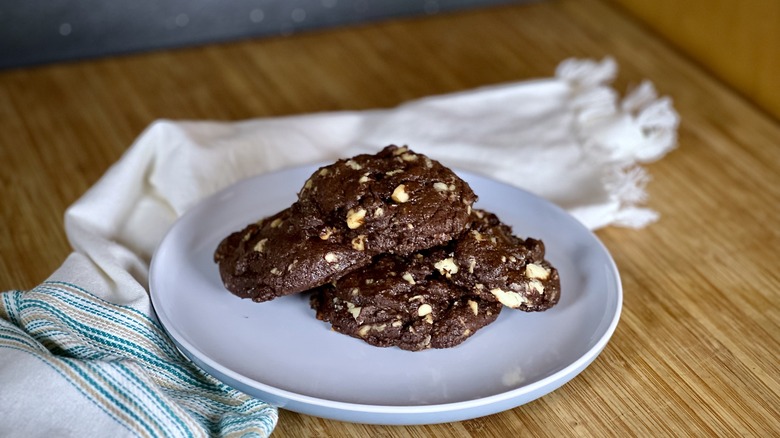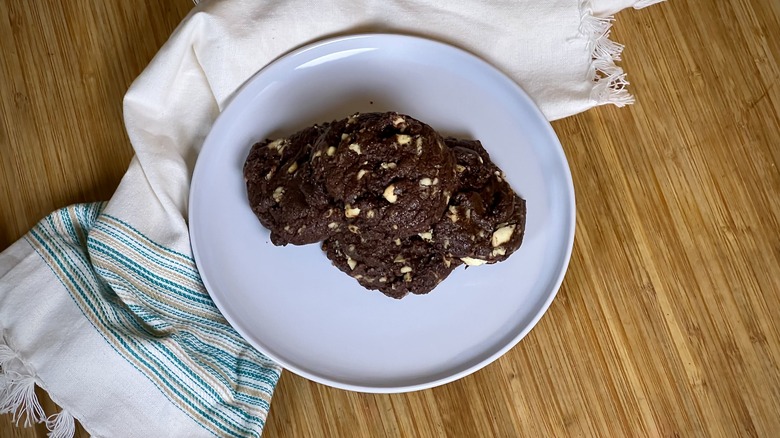Taste Test: Should You Be Adding Feta To Chocolate Cookies?
We're always on the lookout for new and exciting dessert recipes. Anyone can whip up a typical cupcake for the community bake-sale or a present plate of brownies to the new next door neighbor, but we want something new, bold, and inspired. There's no shortage of creative ideas out there, particularly on social media platforms like TikTok and Instagram, but you never know when that innovation actually works or when it will fall flat on its face like cocoa-powder-infused hummus that tastes more like chickpeas than brownies and banana ice cream that lacks the luscious, creaminess of the real deal.
So we were curious about the idea of adding feta cheese to chocolate cookies. A brownie-like cookie rarely disappoints, but we wondered if the use of cheese took the dish from ingenious to weird. It's not that adding cheese to dessert is a novel concept, and we're all about creating sweet-and-salty vibes. The issue here is that we just couldn't wrap our heads around how tangy, briny feta cheese mixes well with chocolate. Our interest was piqued enough to give it a go, so we watched the viral Instagram video that inspired the trend a few times, picked up the necessary ingredients, and got ready to bake. After our taste test, we determined that we would absolutely make this cookie again, with a small modification.
How chocolate feta cookies went viral
The recipe in question comes to us from Carolina Gelen, a recipe developer from Transylvania, Romania, with a million followers on Instagram. Gelen made waves when she debuted a recipe she "selfishly" developed for herself. In the video, she says it's easy to create content that she thinks her viewers might like, but it feels so good to "develop a recipe no one asked for just because you like it." Sure enough, Gelen is all smiles in the video, so it's clear this recipe brings her joy.
The cookie recipe is pretty straightforward: The liquid ingredients consist of unsalted butter, dark chocolate, cocoa powder, brown sugar, white sugar, vinegar, full-fat yogurt, kosher salt, and an egg. Mix that together with all-purpose flour and a few leavening agents (baking soda, baking powder) before folding in a block of feta cheese, and you'll create a soft, fudgy cookie that perfectly balances sweet and salty.
Adding cheese to dessert isn't a new concept
Gelen certainly isn't the first recipe developer to add cheese to a dessert. The most obvious example comes to us in the form of cheesecake (which isn't technically a cake, but it's still delicious). When a soft cheese like cream cheese, Neufchâtel, or ricotta cheese is combined with eggs and sugar, it's transformed into a product that no one would recognize as savory cheese. That same concept works with ricotta cheese-stuffed cannolis. Tiramisu is another one that comes to mind, a combination of a coffee and liquor-soaked sponge cake layered with sweetened mascarpone cheese. One of our favorite sweet-and-salty combinations involves mixing cheddar cheese into pie crust (or melting it straight on top of the slices, if you prefer). The sharp, oily cheese creates a perfect contrast to the sweet apples and buttery crust.
Using feta diverges from these examples, most notably because it's bold, salty, and a little funky. For dessert, it's typically wrapped in phyllo and drizzled with honey, but we don't often see it mixed with chocolate. The more common way to find these salty cheeses for dessert is as a European-style cheese course — after all, cheese can actually help clean your teeth after a meal, increasing saliva production inside the mouth to lower the mouth's acidity levels and help remineralize the teeth. To incorporate cheese into cookie batter, though, is in a whole different realm.
What commenters are saying about the recipe
Gelen's Instagram post received hundreds of comments, and many of them were supportive. Commenters rallied behind the recipe developer, cheering her on with comments like "Do this for you and authenticity rings true" and telling her to keep up the good work. Others were skeptical, saying they were "intrigued and repulsed in equal measures" or they would try it just because she posted it (presumably, these followers had experienced the success of previous recipes). Then, there were the naysayers: "I won't try it in [sic] million years."
For our part, our initial reaction was one of shock. It seemed so strange to use feta specifically — why not a mild-flavored cheese like chevre goat cheese or maybe even a funky soft cheese like Brie or Camembert? We may have written the choice off as a call for attention, but Gelen seemed so authentic about the decision. She had made a dessert containing flavor combinations that meant something to her, which made us reluctantly excited to experience her vision.
The cookies start with a conventional approach
The first few steps were standard for making cookies, starting with browning the butter and using it to melt the chocolate. We like this approach for a few reasons. For starters, using melted butter is a gentle way to temper the chocolate. Chocolate can become stiff and lose its silken shine when overheated, but it's pretty hard to mess it up when it never comes in direct contact with the heat. Browning the butter also toasts the milk solids, adding a caramelized flavor to the cookies. If you're new to the process, use this trick to help you tell if your butter is browned: When you can no longer hear the butter sizzling in the pan, it's finished.
Gelen uses 70% to 80% dark chocolate in her recipe. These percentages measure sweetness, indicating how much of the bar is made from cacao or added sugar. We may the executive decision to use a 60% bar. Though it provides less bitter chocolate flavor than an 80% bar, we figured a little extra sweetness in these cookies wouldn't hurt.
The order you add the ingredients is important
Once the chocolate is melted, it was time to combine the remaining liquid ingredients before adding the dry ingredients. We added the salt, sugar, and brown sugar while the butter was still hot, as the temperature would help melt the sugar and infuse every bite with an equal level of sweetness. After that was all incorporated, we added the full-fat yogurt and egg, letting the mixture cool down slightly just in case the heat caused a curdling effect.
Gelen also calls for a teaspoon of vinegar here, and she doesn't specify which kind. White vinegar and apple cider vinegar are commonly used in baked goods recipes because the acid reacts with the dough's leavening agent, creating carbon dioxide that gives rise to cookies, cakes, and muffins. We decided to go with apple cider vinegar here because it's less sharp than white vinegar, and the fruity aroma would provide a delicate balance between the chocolate and cheese. However, it was used in such small quantities that the effect on flavor would be minimal, so use what you have on hand.
Last but not least, adding the flour, baking powder, and baking soda to the wet batter. Adding the flour too early can create overmixing and a highly-developed gluten network. That's great for something like bread or pizza dough, but it would make the cookies too tough. We recommend sifting the flour and gently mixing it in at the end to create a tender bite.
Opt for block over crumbled feta
Feta is an ancient cheese that's made across the world, and there are some subtle differences between the options you'll find at the grocery store. You can find the cheese from different countries — versions from France, Bulgaria, and Israeli feta are all popular — and it can be made with cow's milk, goat's milk, sheep's milk, or a combination.
While we could make an argument about buying feta stored in brine for savory applications, we chose to follow Gellen's lead and use a block for this recipe. It makes sense from a baking science perspective since cheese stored in brine might have a higher water content than block feta, which could throw off the ratio of liquid to dry ingredients. We debated buying a crumbled version so we wouldn't have to dirty our hands when we added it to the batter, but we worried it might be too dry. So, to ensure the recipe turned out on our first attempt, we stuck with the block.
It gets a little weird when you add the cheese
Our batter had come together to form a gorgeous dough, and now was the moment when we would normally fold in chocolate chips. Instead, we unwrapped the feta and crumbled it through our fingers. It felt a little strange to let it fall into the bowl — like we had accidentally mixed up our dessert and salad prep — but the odd feeling left us as soon as we mixed it into the dark brown cookie batter. It seemed like it contained a lot of cheese, but the dough seemed normal when it was all folded in, and it ended up looking like large chunks of white chocolate.
We know you're not supposed to eat raw cookie dough, but we couldn't help but sneak a peek and what was yet to come. It was surprisingly good, and we were bolstered in our decision to actually go through with this. The batter had everything you'd want in a dessert, balancing sweet with bitter notes from the chocolate, nuttiness from the butter, but it also contained a salty, slightly sour character from the feta that we found interesting. After letting the dough solidify in the fridge for a few hours, we scooped it onto a parchment-lined baking sheet and baked them until the batter in the center had transformed from raw to cooked, moving the slightly gooey cookies to a wire rack to firm up as they cooled.
How it went making chocolate feta cookies
Overall, the process was pretty painless other than the weirdness of putting an entire block of cheese into a sweet dessert, of course. The only snafu we ran into was refrigerating the batter for at least two hours, which we didn't realize was a requirement until we reached that step (yes, we committed the cardinal sin of not reading ahead when baking!). We ended up storing them in the fridge overnight, which solidified the batter into a mixture so hard it almost broke our ice cream scoop. Perhaps overnight was a little too long, so we'll be better at planning ahead next time.
We were also a little concerned about the large cookies as they went into the oven. Gelen specifically advised against flattening the dough balls, and we saw them naturally flatten and melt as they cooked in her video. Our concerns were unfounded and they turned out a perfect density. Our cookies did take an extra minute (15 minutes instead of the 12 to 14 minute range), which probably varies from oven to oven.
The only other thing worth noting was the smell. Around the 10 minute mark, the kitchen filled with the pleasant aroma of baking chocolate mingled with the lightly soured smell of feta. Our brains were confused, and we had to strengthen our resolve to try the cookies anyway.
What do chocolate feta cookies taste like?
These cookies were simultaneously fantastic and a little strange, all wrapped up in a tiny package. We loved all the chocolate aspects of this cookie, from the perfectly rich, nutty flavor to the texture of the cookie itself. Gelen describes them as soft, chewy cookies with a fudgy flavor that's reminiscent of a brownie, and it's a pretty spot-on description.
When it comes to the feta, we did enjoy the how it participated in a gorgeous interplay of textures between the cookie's lightly crunchy bottom, the soft, gooey inside, and the firm chunks of cheese. However, that's where our love for the feta stops. We used the same brand of feta as the recipe developer, but we found it wasn't quite salty enough to bring much of a sweet-and-salty vibe (unless you get a bite with a larger chunk). The bigger issue for us was that it left a lingering sour flavor on our palate. We found ourselves sprinkling coarse sea salt on top of the cookie to amp up its salinity while avoiding the bites that contained the tart feta. Although we loved the texture, that sourness was a bit of a deal breaker for us, so experimenting with other types of feta will be our game plan next time around. Greek feta is said to have the tangiest flavor, so using a salty Bulgarian feta or a creamy French feta might be a better choice.
The verdict: Yes on the cookies, but no cheese please
There's a lot to love about this recipe, starting with simply celebrating flavors that make you happy. There's a perfect cookie out there for everyone, and we're stoked that Gelen found hers. We also appreciated how easy it was to make these. With the exception of the step that requires cooling the batter for at least two hours, this recipe didn't require a lot of technical prowess (other than knowing when to pull the brown butter), and we had most of the ingredients on-hand in the pantry.
Would we make these cookies again with feta? Definitely not with Greek feta, although we'd be willing to try again with other types to see if they're a better fit. Overall, this feels like a niche recipe that may be a winner for some but won't be an overall crowd-pleaser. However, we would 100% bake another batch without the feta, no questions asked. We love the fudgy texture of the brownie-like cookie, and it was as full-flavored as a chocolate cookie gets. Maybe next time, we'll swap another sweet ingredient for the feta — like white chocolate chips or salted caramel to preserve the sweet-and-salty vibe. We'd even go with chopped bacon pieces (after all, bacon fat cookies are all the rage these days). But unless we're hosting a cheese-lover for dinner, we'll probably take a pass on the feta-chocolate combo.
